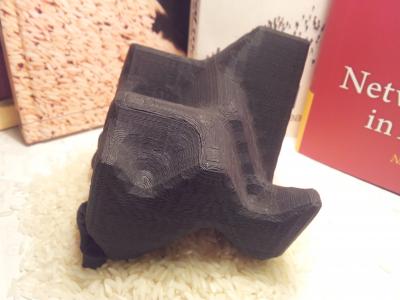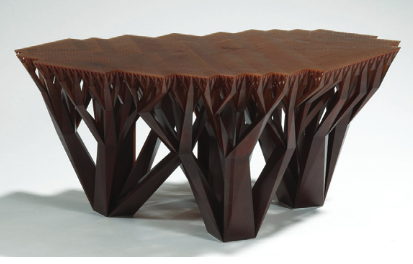Using 3D printing to explain theoretical physics
December 10, 2013

Researchers have successfully demonstrated how complex theoretical physics can be transformed into a physical object using a 3D printer (credit: Imperial College London/EPL)
Students may soon be able to reach out and touch some of the theoretical concepts they are taught in their physics classes thanks to a novel idea devised by a group of researchers from Imperial College London.
In new study published December 9 in the journal EPL, the researchers successfully demonstrated how complex theoretical physics can be transformed into a physical object using a 3D printer.
Sculplexity
In just eight hours and at the cost of around 15 euros, they were able to use a commercially available 3D printer to create their own physical object based on a mathematical model that described how forest fires can be started and how they eventually spread over time.
The researchers labeled the approach “Sculplexity” — sculptures of complexity — and believe it could also be used to produce works of art based on science, or transform the way that ideas and concepts are presented and discussed within the scientific community.
“The work was inspired by a visit to the Victoria and Albert Museum in London where I came across the first ever 3D printed object the museum had acquired,” said Dr. Tim Evans, a theoretical physicist at Imperial and a co-author of the study.
“The object was a table inspired by the tree-like structures found in nature, which is an example of a branching process that is commonly encountered in complex systems in theoretical physics. This led me to think, what other processes familiar to physics could be turned into a 3D printed object?”
In their study, the researchers used a forest fire as an example, in which each cell represented a tree which could either be alive, dead or burning. The exact state that each cell occupied over time depended on a set of rules, which took into account the cell’s proximity to other cells that may be burning or if it was struck by lightning.
Building a 3D model in layers

The Fractal.MGX coffee table, created out of epoxy resin using a stereo-lithography 3D printing process (credit: WertelOberfell GbR and Stephane Briolant)
“The basic idea is simple,” said Evans. “A 3D printer builds up its object in layers. So the height of the object can be thought of as time. Suppose you have a mathematical model which defines a flat, two-dimensional picture that evolves in time — typically this will be a grid with some squares full and some empty.
“The mathematical model will define at each point in time what the printer should print at one height. The next step in the model will then define what to print on top of the first layer, and so forth. The result is a 3D object which shows how the mathematical model has evolved over time.
“In our own group at Imperial we are trying to explain heartbeat anomalies by looking at simple models for the behavior of individual cells in heart muscle — it’s possible that this could be visualized using 3D printing. Most models that represent the spread of disease could also be visualized.
Abstract of EPL (Europhysics Letters) paper
We show how to convert models of complex systems such as 2D cellular automata into a 3D printed object. Our method takes into account the limitations inherent to 3D printing processes and materials. Our approach automates the greater part of this task, bypassing the use of CAD software and the need for manual design. As a proof of concept, a physical object representing a modified forest fire model was successfully printed. Automated conversion methods similar to the ones developed here can be used to create objects for research, for demonstration and teaching, for outreach, or simply for aesthetic pleasure. As our outputs can be touched, they may be particularly useful for those with visual disabilities.